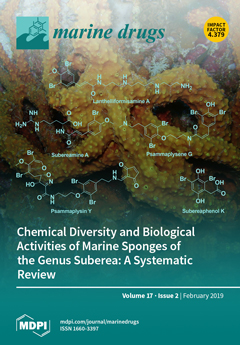Fucosylated oligosaccharide (FO) is known to selectively promote the growth of probiotic bacteria and is currently marketed as a functional health food and prebiotic in infant formula. Despite widespread interest in FO among functional food customers, high production costs due to high raw material costs, especially those related to fucose, are a significant production issue. Therefore, several actions are required before efficient large-scale operations can occur, including (i) identification of inexpensive raw materials from which fucosylated oligosaccharides may be produced and (ii) development of production methods to which functional food consumers will not object (e.g., no genetically modified organisms (GMOs)).
Undaria pinnatifida, commonly called Miyeok in Korea, is a common edible brown seaweed plentiful on the shores of the Korean peninsula. In particular, the sporophyll of
Undaria pinnatifida contains significant levels of
l-fucose in the form of fucoidan (a marine sulfated polysaccharide). If the
l-fucose present in
Undaria pinnatifida sporophyll was capable of being separated and recovered,
l-fucose molecules could be covalently joined to other monosaccharides via glycosidic linkages, making this FO manufacturing technology of value in the functional food market. In our previous work, β-galactosidase (EC 3.2.2.23) from
Bifidobacterium longum RD47 (
B. longum RD47) was found to have transglycosylation activity and produce FO using purified
l-fucose and lactose as substrates. In this research, crude fucodian hydrolysates were separated and recovered from edible seaweed (i.e.,
U. pinnatifida sporophyll). The extracted
l-fucose was purified via gel permeation and ion exchange chromatographies and the recovered
l-fucose was used to synthesize FO.
B. longum RD47 successfully transglycosilated and produced FO using
l-fucose derived from
Undaria pinnatifida and lactose as substrates. To the best of our knowledge, this is the first report of synthesized FO using
Bifidobacterium spp.
Full article






